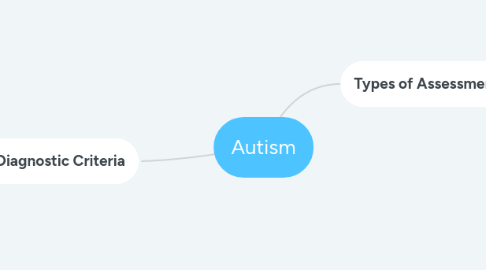
1. DSM-V Diagnostic Criteria
1.1. Autism Spectrum Disorder 299.00 (F84.0)
1.1.1. Deficits in social-emotional reciprocity, ranging, for example, from abnormal social approach and failure of normal back-and-forth conversation; to reduced sharing of interests, emotions, or affect; to failure to initiate or respond to social interactions.
1.1.2. Deficits in nonverbal communicative behaviors used for social interaction, ranging, for example, from poorly integrated verbal and nonverbal communication; to abnormalities in eye contact and body language or deficits in understanding and use of gestures; to a total lack of facial expressions and nonverbal communication.
1.1.3. Deficits in developing, maintaining, and understanding relationships, ranging, for example, from difficulties adjusting behavior to suit various social contexts; to difficulties in sharing imaginative play or in making friends; to absence of interest in peers.
1.2. Social (Pragmatic) Communication Disorder 315.39 (F80.89)
1.2.1. Persistent difficulties in the social use of verbal and nonverbal communication as manifested by all of the following:
1.2.1.1. Deficits in using communication for social purposes, such as greeting and sharing information, in a manner that is appropriate for the social context.
1.2.1.2. Impairment of the ability to change communication to match context or the needs of the listener, such as speaking differently in a classroom than on the playground, talking differently to a child than to an adult, and avoiding use of overly formal language.
1.2.1.3. Difficulties following rules for conversation and storytelling, such as taking turns in conversation, rephrasing when misunderstood, and knowing how to use verbal and nonverbal signals to regulate interaction.
1.2.1.4. Difficulties understanding what is not explicitly stated (e.g., making inferences) and nonliteral or ambiguous meanings of language (e.g., idioms, humor, metaphors, multiple meanings that depend on the context for interpretation).
1.2.2. The deficits result in functional limitations in effective communication, social participation, social relationships, academic achievement, or occupational performance, individually or in combination.
1.2.3. The onset of the symptoms is in the early developmental period (but deficits may not become fully manifest until social communication demands exceed limited capacities).
1.2.4. The symptoms are not attributable to another medical or neurological condition or to low abilities in the domains or word structure and grammar, and are not better explained by autism spectrum disorder, intellectual disability (intellectual developmental disorder), global developmental delay, or another mental disorder.
2. Types of Assessments
2.1. Diagnostic Assessments
2.1.1. Autism Diagnostic Interview - Revised
2.1.2. Prelinguistic Autism Diagnostic Observation Schedule
2.1.3. Childhood Autism Rating Scale
2.1.3.1. Relating to people
2.1.3.2. Imitation
2.1.3.3. Emotional response
2.1.3.4. Body use
2.1.3.5. Object use
2.1.3.6. Adaptation to change
2.1.3.7. Visual response
2.1.3.8. Listening response
2.1.3.9. Taste, smell, and touch response and use
2.1.3.10. Fear or nervousness
2.1.3.11. Verbal communication
2.1.3.12. Nonverbal communication
2.1.3.13. Activity level
2.1.3.14. Level and consistency of intellectual response
2.1.3.15. General impressions
2.1.4. Autism Behavior Checklist
2.1.5. Checklist for Autism in Toddlers
2.1.6. Real Life Rating Scale
2.1.7. Pervasive Developmental Disorder Screening Test
2.1.8. Autism Screening Instrument for Educational Planning (2nd ed.)
2.1.9. Diagnostic Checklist for Behavior-Disturbed Children (Form E-2)
2.1.10. Gilliam Autism Rating Scale
2.2. Developmental Assessments
2.2.1. Psychoeducational Profile-Revised
2.2.2. Southern California Ordinal Scales of Development
2.2.3. Developmental Play Assessment Instrument
2.2.4. Brigance Inventory of Early Development
2.3. Adaptive Assessments
2.3.1. Vineland Adaptive Behavior Scales
2.4. Communication Assessments
2.4.1. Sequenced Inventory of Communication Development (Rev. ed.)
2.4.2. The Nonspeech Test for Receptive/Expressive Language
2.4.3. Assessing Semantic Skills Through Everyday Themes
2.4.4. Expressive One-Word Picture Vocabulary Test (Rev. ed.)
2.4.5. Receptive One-Word Picture Vocabulary Test (Rev. ed.)
2.4.6. Clinical Evaluation of Language Fundamentals – Preschool
2.4.7. ECOScales
2.4.8. Peabody Picture Vocabulary Test (III)
2.4.9. Reynell Developmental Language Scales
2.4.10. Preschool Language Scale (3rd ed.)
2.5. Infant/Toddler Assessments
2.5.1. Bayley Scales of Infant Development (2nd ed.)
2.5.2. Mullen Scales of Early Learning
2.5.3. Early Coping Inventory
2.6. Standardized Tests of Intelligence
2.6.1. Wechsler Preschool and Primary Scale of Intelligence (Rev. ed.)
2.6.2. Wechsler Intelligence Scale for Children (3rd ed.)
2.6.3. Differential Ability Scales
2.6.4. Stanford-Binet Intelligence Scale (4th ed.)
2.7. Tests of Nonverbal Intelligence
2.7.1. Columbia Mental Maturity Scale (3rd ed.)
2.7.2. Merrill-Palmer Scale of Mental Tests
2.7.3. Leiter International Performance Scale
2.7.4. Test of Nonverbal Intelligence (2nd ed.)
2.8. Academic Screening
2.8.1. Wide Range Achievement Test 3 (WRAT3)
2.9. Behaviour Assessment
2.9.1. Achenbach Child Behavior Checklist
2.9.2. Analysis of Sensory Behavior Inventory (Rev. ed.)
2.10. Family Assessment
2.10.1. Behavioural Vignettes Test
2.10.2. Parenting Satisfaction Scale
2.10.3. Parenting Stress Index (3rd ed.)
2.10.4. The Parental Stress Scale
2.10.5. Questionnaire on Resources and Stress
2.10.6. Family Adaptability and Cohesion Evaluation Scales III
2.10.7. Family Assessment Interview
2.10.8. Child Improvement Locus of Control Scale
2.10.9. Family Environmental Scale
2.11. Other Assessments
2.11.1. Standardized videotape assessment
2.11.2. Complete medical examination
2.11.3. Audiometric assessment

